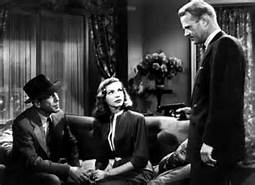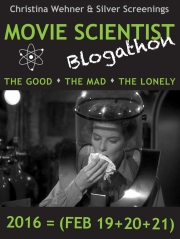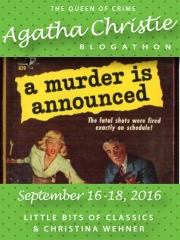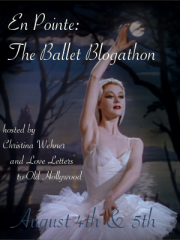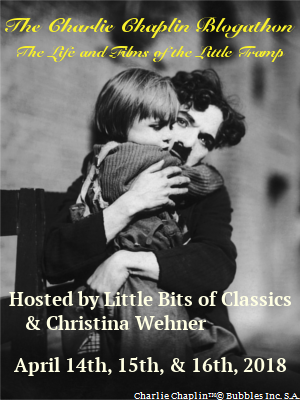![220px-Bigsleep2[1]](https://christinawehner.wordpress.com/wp-content/uploads/2014/05/220px-bigsleep21.jpg?w=645) It is practically axiomatic that The Big Sleep does not make sense. When director Howard Hawks asked author Raymond Chandler who had killed the chauffeur, Chandler wired back that he had no idea. Somehow, that lack of clarity has only enhanced the mystique of the story…especially the movie.
It is practically axiomatic that The Big Sleep does not make sense. When director Howard Hawks asked author Raymond Chandler who had killed the chauffeur, Chandler wired back that he had no idea. Somehow, that lack of clarity has only enhanced the mystique of the story…especially the movie.
The reasons for the confusion in the film are three-fold: the book never made that much sense anyway, the studio wanted a romance between Humphrey Bogart and Lauren Bacall, which came at the cost of clarity, and the Hays Code was in effect, which meant that there were many things that could be written about which could not be shown on screen.
I read the book, therefore, in the hope that it would elucidate certain aspects of the film, which it mostly did.
The Big Sleep (1939), by Raymond Chandler
What Roger Eberts writes of the movie could also be written of the book, that it is “about the process of a criminal investigation, not its results.” Private detective Philip Marlowe is hired to look into the blackmailing of General Sternwood’s daughter, Carmen, but everyone – including his other daughter, Vivien – assume that he was hired to look into the disappearance of Vivien’s husband, Rusty Regan.
There are two parts to the book. The first half deals with the death of Carmen’s blackmailer, as well as other sundry murders and sordid affairs. The second half deals with Marlowe’s search for Regan, which involves a lot of the same characters who were involved in the death of the blackmailer, like the casino owner whose wife supposedly ran off with Rusty Regan and seems to have something on Vivien.
There were obviously quite a few aspects of the book that were not allowed in the movie. It’s not so much that the movie changed things (though it did change things), but that it let certain details drop out of the picture. The result was a general lack of understandable motivation for certain characters. Why did this one young man randomly show up and shoot this other man? Oh, the blackmailer was his lover, but he shoots the wrong man because the real murderer was the chauffeur who died (nobody knows how). And what does it mean to be running “a racket?” Oh, that’s a pornographic shop. That makes sense.
Another, significant, difference is that there is no romance in the book. A romance would be too hopeful for a hardboiled detective novel, where women are wild and licentious and men are cynical and cold.
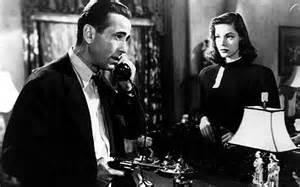 The Big Sleep (1946) Starring Humphrey Bogart and Lauren Bacall – Directed by Howard Hawks – Screenplay by William Faulkner, Leigh Brackett, Jules Furthman
The Big Sleep (1946) Starring Humphrey Bogart and Lauren Bacall – Directed by Howard Hawks – Screenplay by William Faulkner, Leigh Brackett, Jules Furthman
I’m not sure if Chandler was pleased with the movie adaptation of his book, but he did feel that the actress playing Carmen (Martha Vickers) completely outshone Lauren Bacall as Vivien in the early release of the film. He felt that when the script was rewritten to increase Bacall’s part and decrease Vicker’s, it further confused the plot.
Bogart and Bacall were currently an item. They had met and fallen in love in the very successful 1944 film To Have and Have Not. During the filming of The Big Sleep, Bogart was going through a divorce so he could marry Lauren Bacall. There had been an overwhelmingly positive reaction to the chemistry between the two in the film and the studio wanted to capitalize on that.
They made one version of the movie and released it in 1945 to the troops overseas. However, Bacall’s agent was concerned that she was being overshadowed and since she had just starred in a dud film with Charles Boyer, her agent was concerned about her career and persuaded the studio to shoot some more scenes and cut out a few others. The result was a delightful combination detective/noir/romance – not a usual combination. Most noirs end in tears…or at the very least death, misery or despair for all.
The book ends on a sour note. Spoiler! Rusty Regan was killed by Carmen because he rebuffed her advances and Vivien was trying to hide the fact. End Spoiler! Marlowe notes how he has now become part of the general nastiness of the characters, but that at least he can spare the general any part in it. It’s not an upbeat ending. But the movie is far less nasty (nastiness still occurs, but is not so tainting).
![img14[1]](https://christinawehner.wordpress.com/wp-content/uploads/2014/05/img141.jpg?w=300&h=168) In fact, Marlowe, in the movie, is a genuine hero, unlike his Sam Spade from The Maltese Falcon (1941). Sam Spade has no particular morals or convictions (apart from not letting people get away with shooting his partner – even if he didn’t like the man, but it’s the principle that counts), but Bogart’s Philip Marlowe does, if not have morals, at least have a code, as he’s striving to do right, catch the criminals, spare his client and help the woman he loves out of the jam she’s in.
In fact, Marlowe, in the movie, is a genuine hero, unlike his Sam Spade from The Maltese Falcon (1941). Sam Spade has no particular morals or convictions (apart from not letting people get away with shooting his partner – even if he didn’t like the man, but it’s the principle that counts), but Bogart’s Philip Marlowe does, if not have morals, at least have a code, as he’s striving to do right, catch the criminals, spare his client and help the woman he loves out of the jam she’s in.
Note: for a witty and spot-on article about The Big Sleep film, The Man on The Flying Trapeze writes in the chivalric vein of the many ways that he loves the film. He calls the film a “screwball noir” and Marlowe “Sir Galahad in a 1938 Plymouth coupe who saves the honor of the Sternwood family while falling in love with one of the princesses.” This article is what inspired me to watch the movie, and also to read the book.
